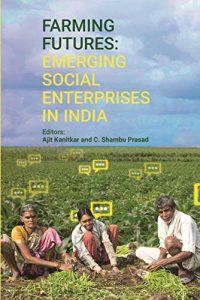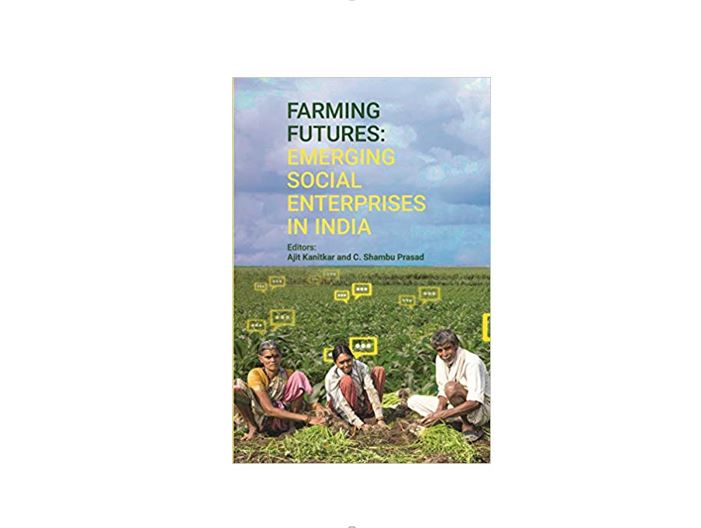Editors: Ajit Kanitkar and C Shambhu Prasad (2019)
Authors Upfront Publishing Services Private Limited
ISBN: 9789387280465
Pages: 533
In recent years, there has been a lot of interest and discussion on agripreneurship and startups, as well as in attracting youth to agriculture and agribusinesses on various platforms, both in India and internationally. Both conventional farmers of the older generation and rural youth are frequently disenchanted with agriculture due to the multiple problems and hardships they suffer, including the generally low returns from agriculture. We often hear a lot of negative stories of farmer suicides and other problems. Yet, some enterprising individuals here and there are excited about agriculture, thus showing a ray of hope. Also, we find a new breed of emerging farmers who have no background in agriculture. Surprisingly, many such individuals now want to enter into agriculture giving up their high profile jobs in MNCs. The stories of engineers and professionals taking up organic agriculture and other high tech farming ventures across India and earning millions are rising in numbers, at least as seen in media. This book is largely about such individuals, professionals and farmers, who have shown how to ensure profits from agriculture by doing things a bit differently.
 The 15 cases presented in this book showcase unique, and distinct grassroots agri-enterprises. I have read numerous success stories of farmers before, but I found this book uniquely different in the way each case has been chosen and treated. Each case reflects innovative efforts that have not only offered solutions to chronic problems, but have also made an impact in reaching customers /consumers and winning their confidence. The cases are from various states including some with an all-India scope, dealing with diverse aspects. These include: water conservation, millets forming part of a food basket, digital platforms, warehousing services, substitutions for high value imported irrigation controllers, buying fresh produce, promoting value chains for farmers, market linkages for farmers producing fruits and vegetables, market for a volatile perishable crop like tomato, ethical business practices in marketing of milk, producing safe non-pesticide agricultural produce, co-creation of machinery design, weather advisory services, access to market for scattered producers, and creating access and market linkages. The focus is not only on the primary production of agro commodities, but also on activities in the entire value chain/s that offer opportunities which can be harnessed to make a profit. The need for farmers to go beyond just production of agro commodities has been emphasized very nicely.
The 15 cases presented in this book showcase unique, and distinct grassroots agri-enterprises. I have read numerous success stories of farmers before, but I found this book uniquely different in the way each case has been chosen and treated. Each case reflects innovative efforts that have not only offered solutions to chronic problems, but have also made an impact in reaching customers /consumers and winning their confidence. The cases are from various states including some with an all-India scope, dealing with diverse aspects. These include: water conservation, millets forming part of a food basket, digital platforms, warehousing services, substitutions for high value imported irrigation controllers, buying fresh produce, promoting value chains for farmers, market linkages for farmers producing fruits and vegetables, market for a volatile perishable crop like tomato, ethical business practices in marketing of milk, producing safe non-pesticide agricultural produce, co-creation of machinery design, weather advisory services, access to market for scattered producers, and creating access and market linkages. The focus is not only on the primary production of agro commodities, but also on activities in the entire value chain/s that offer opportunities which can be harnessed to make a profit. The need for farmers to go beyond just production of agro commodities has been emphasized very nicely.
The authors and editors have taken prior consent from the entrepreneurs and thus they could secure full cooperation in profiling their stories. This has enabled the authors to acquire detailed information that goes far in analyzing specific contexts. If anyone is interested in the effective presentation of the cases, they will appreciate that drafts of these cases were presented at the case writers’ workshop at IRMA for comments and suggestions. Not many case study writers follow this approach of seeking constructive suggestions which can help in improving the quality of presentation. Each of the cases profiled is an outcome of field visits and interactions with the local eco-system-farmers, bankers, investors, NGOs, incubators, and customers. It is appreciable that the authors have tried to be as objective as possible, by even looking at financial statements (balance sheets), which very often many authors skip doing. The well-outlined cases present answers to questions such as: How do these enterprises apply the ‘social’ aspect in their work and functioning? Whom do they serve, and how do they do that? Are they really an enterprise? Does their business model help them to generate sufficient revenues while serving the customers they want to serve?
The book is the outcome of a year-long research at Vikas Anvesh Foundation (VAF) by fifteen accomplished authors consisting of academics, researchers, consultants, practitioners, grant makers from philanthropic institutions, and social investors. At the end of the book a list furnishes the profiles of all the contributors, which is quite impressive given their background and work experience. It is very appreciable that, at the end of each case report, the researcher’s analysis has been presented in a box, which to me is the most important part of the case presented. This analysis presents the key learning derived from the study, which could give ideas for further developments in the given or a related venture. These cases offer hope to not only rural youths who are mostly disenchanted with agriculture, but also to first-generation entrepreneurs predominantly from non-agriculture backgrounds, by demonstrating the viability of farm enterprises. These include innovations in providing more efficient and non-exploitative linkages to markets and consumers, providing affordable aids and equipment for farming, and reducing the information asymmetry – all of which farmers have when dealing within the market. The inclusion of relevant photos adds great value to the content as we know a photo is worth a thousand words.
I suggest that readers not be selective in reading only a few cases, but they should read all fifteen since every case is so unique, interesting and full of insights on what works and what doesn’t work, and why and how it could be made to work. Also, make it a point to read the first two chapters which give an overview of social enterprises and social entrepreneurs in agriculture in India. Chapter 18, the final chapter, on ‘Emerging change makers – Insights from the study of social enterprises’, written by the editors themselves, contains the important summative discussion of this book and is a ‘must read’. The editors have synthesized each case and tried to relate it with the limitations and possibilities of scaling up the model, including necessary policy changes and other forms of support. In conclusion, the editors mention that their research has raised several questions that need to be further explored by researchers. Appreciably, they have listed twenty-four research questions/issues related to governance, promoting institutions/ecosystem, knowledge building interactions between practice-research-funding and compliance reporting/data/impact measurement, for future research.
Finally, being an agricultural extension professional, I could relate to this book, specifically to the Agripreneurship Development course in the undergraduate or postgraduate curriculum in some universities. Also, when I see the various modules developed under GFRAS-New Extensionist Learning Kit (NELK), particularly the one on Agricultural Entrepreneurship, I see that these cases are excellent examples that lead to a clearer understanding of the theoretical concepts. This book contributes significantly towards improving developmental practices in India specifically. The stakeholders in agriculture/rural development engaged in various capacities viz., as researchers, academics or officials of development departments, as well as the students of agricultural extension and rural development are likely to find this book insightful. As many as 14 highly accomplished professionals from various backgrounds have written commendations for this book, which itself reflects its importance.
Despite my efforts to find this book’s drawbacks, I failed. So this is my best compliment to all the authors and editors for offering such an outstanding work.
Mahesh Chander

Dr Mahesh Chander (drmahesh.chander@gmail.com) Head, Division of Extension Education, ICAR-Indian Veterinary Research Institute, Izatnagar (UP), INDIA.





Add Comment